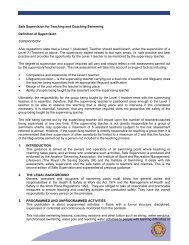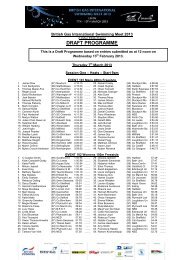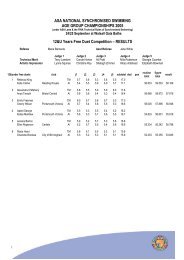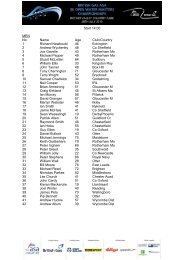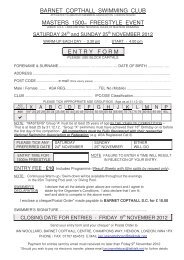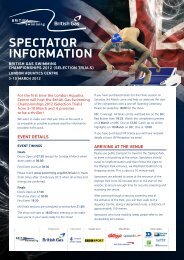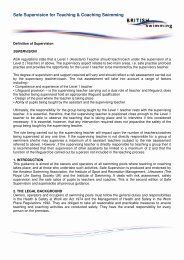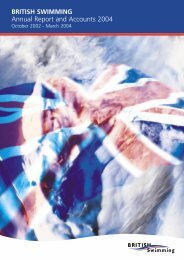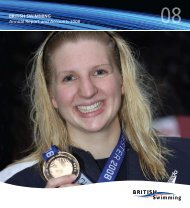Inclusion of Swimmers with a Disability - Swimming.Org
Inclusion of Swimmers with a Disability - Swimming.Org
Inclusion of Swimmers with a Disability - Swimming.Org
Create successful ePaper yourself
Turn your PDF publications into a flip-book with our unique Google optimized e-Paper software.
Classification<br />
Classification, where the aim is to<br />
“ensure a fair playing field for all<br />
swimmers”, is a requirement <strong>of</strong> many<br />
competitions. There are two main<br />
forms <strong>of</strong> classification:<br />
Minimum eligibility criteria for Functional<br />
classification system (S1-S15)<br />
The groups S(SB)(SM) 1-10 are for those<br />
swimmers <strong>with</strong> a functional, visual,<br />
learning or hearing impairment.<br />
S(SB,SM) 11-13<br />
Visually impaired swimmers<br />
The degree <strong>of</strong> vision is measured (<strong>with</strong><br />
the best correction) ranging from blind<br />
to visually impaired.<br />
Functional system<br />
This system means that amputees,<br />
people <strong>with</strong> paraplegia, cerebral palsy<br />
and other physical disabilities can<br />
compete together. It is a swimmer’s<br />
functional ability i.e. range and power<br />
<strong>of</strong> movement and co-ordination that<br />
determines their classification group.<br />
<strong>Disability</strong> Specific Classification system<br />
This system allows swimmers <strong>of</strong> a<br />
similar and specific disability to compete<br />
against one another. There are individual<br />
classification systems for visually<br />
impaired, hearing impaired and<br />
learning impaired swimmers.<br />
S1-S10 (SB1-SB9=Breaststroke)<br />
(SM1-SM10=Medley)<br />
The following disabilities meet the<br />
requirements <strong>of</strong> the functional<br />
classification system unless the<br />
impairment is extremely minimal.*<br />
l Achondroplasia (dwarfism)<br />
l Amputation (including dysmelia)<br />
l Arthrogryposis<br />
l Cerebral Palsy<br />
l Legge Perthes<br />
l Osteogenis imperfecta (brittle bones)<br />
l Multiple Sclerosis<br />
l Muscular Dystrophy<br />
l Polio<br />
l Spina Bifida<br />
l Spinal Cord injury.<br />
*Please note this list is not exhaustive,<br />
however it provides a guide to<br />
functional classification eligibility.<br />
S, SB,SM 14<br />
<strong>Swimmers</strong> <strong>with</strong> a learning disability<br />
<strong>Swimmers</strong> must have an IQ <strong>of</strong> 75 or less<br />
to meet the criteria.<br />
S, SB,SM 15<br />
<strong>Swimmers</strong> <strong>with</strong> a hearing impairment<br />
Any swimmer who wears a hearing aid<br />
will be considered.<br />
There are a number <strong>of</strong> conditions that<br />
do not meet the classification criteria<br />
and some <strong>of</strong> them are listed below:<br />
l ADHD<br />
l Aspergers<br />
l Asthma<br />
l Autistic Spectrum<br />
l Epilepsy<br />
l Cystic Fibrosis<br />
l Diabetes<br />
l Dyspraxia<br />
l Haemophilia<br />
l Hydrocephalus<br />
l Obesity<br />
l Scoliosis<br />
l Learning Difficulties<br />
l Transplantees.<br />
<strong>Disability</strong> Specific Classification system<br />
Details can be found on the disability<br />
specific sports organisation websites<br />
(see page 25).<br />
22



